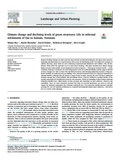| dc.contributor.author | Roy, Manoj | |
| dc.contributor.author | Shemdoe, Riziki | |
| dc.contributor.author | Hulme, David | |
| dc.contributor.author | Mwageni, Nicholaus | |
| dc.contributor.author | Gough, Alex | |
| dc.date.accessioned | 2021-02-24T11:55:58Z | |
| dc.date.available | 2021-02-24T11:55:58Z | |
| dc.date.issued | 2018 | |
| dc.identifier.citation | Manoj Roy, Riziki Shemdoe, David Hulme, Nicholaus Mwageni, Alex Gough, Climate change and declining levels of green structures: Life in informal settlements of Dar es Salaam, Tanzania, Landscape and Urban Planning,
Volume 180, 2018, Pages 282-293,
ISSN 0169-2046, https://doi.org/10.1016/j.landurbplan.2017.11.011 | |
| dc.identifier.uri | https://opendocs.ids.ac.uk/opendocs/handle/20.500.12413/16380 | |
| dc.description.abstract | Impacts of climate change are often acute for those who live in informal settlements, the places where poverty,inequality and deprivation are concentrated in cities across the developing world. To broaden the strategies toaddress this issue, many cities are now embracing ecosystem-based adaptation and resilience. But, in Sub-Saharan Africa (SSA) the approach is yet to make much headway. This paper examines how climate changeimpacts on poor urban people via one component of urban ecosystem−urban green structures (UGS)−in Dares Salaam, Tanzania. It examines: the UGS of importance to the city's informal dwellers and the range of derivedservices; changes over time to these UGS and derived services; and emerging adaptation practices. Using qua-litative methods, the study has three keyfindings. First, cultural ecosystem services are of greatest importance toinformal dwellers, although they do harness a range of other services. Second, the city's UGS have undergonedramatic changes due to both climatic and non-climatic factors. This has resulted in a gradual decline in thequantity and quality of UGS-derived services for the urban poor. Third, in responding to these changes, informalsettlement dwellers have relied mostly on their personal, and sometimes on their collective, resources andcapabilities. There are some innovative practices that draw on external institutions, but access to externalsupport for informal communities has remained consistently low. City authorities should approach and plangreening‘for’(not‘in’) informal settlements as a targeted environmental improvement endeavour–referred tohere as‘creative urban planning’. | |
| dc.publisher | Published by Elsevier B.V. | |
| dc.rights.uri | https://creativecommons.org/licenses/by/4.0/ | |
| dc.title | Climate Change and Declining Levels of Green Structures: Life in Informal Settlements of Dar es Salaam, Tanzania | |
| dc.type | Article | |
| dc.rights.holder | © 2018 The Authors. Published by Elsevier B.V. | |
| dc.identifier.externaluri | http://dx.doi.org/10.1016/j.landurbplan.2017.11.011 | |
| dc.identifier.ag | ES/H033793/1 | |
| dc.identifier.doi | 10.1016/j.landurbplan.2017.11.011 | |


